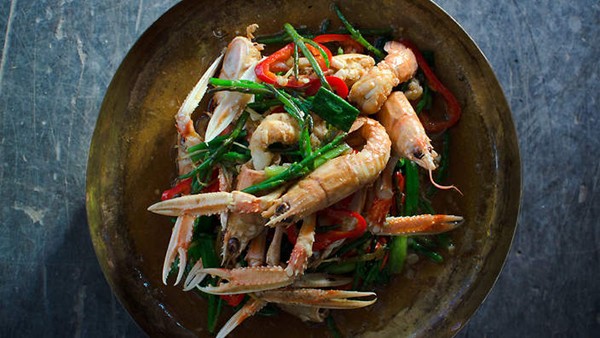The breath of the wok
January 22, 2020 by DarcieWok cooking aficionados extol the virtues of the versatile cookware with a fervor matched only by perhaps the most dedicated cast iron enthusiasts. The wok’s unique shape holds the key to how it can perform so well on different types of food. It’s more than just the slope of the sides, however, as a recent San Francisco Chronicle article explains. It takes a deep dive into the science behind wok cooking.

You may have heard the term “wok hei,” which translated into English means “the breath of the wok,” but you may not understand what that means in practical terms. The article explains that wok hei “refers to the flavor generated by wok-tossing food in a circular motion over a high-powered flame burner. This technique flings oil droplets above the edge of a wok to briefly kiss the flames that wrap around the bowl before falling back to safety in the center of the pan.”
In the hands of a skilled user, a wok can produce wondrous results. The story tells us how chefs can use the intense thermal properties of a cast-iron wok to produce noodles that are shatteringly crisp on the outside and perfectly chewy in the middle, and the various ways that vegetables can be cooked to perfection as well. If this article doesn’t make you pine for a powerful burner and a well-seasoned wok, I don’t think anything could.
Categories
- All Posts (7081)
- Antipasto (2210)
- Author Articles (250)
- Book News (944)
- Cookbook Giveaways (996)
- Cookbook Lovers (262)
- Cooking Tips (116)
- Culinary News (300)
- Food Biz People (558)
- Food Online (800)
- Holidays & Celebrations (277)
- New Cookbooks (154)
- Recipes (1520)
- Shelf Life With Susie (231)
- What's New on EYB (134)
Archives
Latest Comments
- demomcook on Getting to the heart of it
- Ganga108 on Getting to the heart of it
- emi10383 on French at Heart – Cookbook Giveaway
- emi10383 on 20 Amici – 40 Ricette Cookbook Giveaway
- emi10383 on For the Love of Lemons by Letitia Clark – Giveaway
- emi10383 on Balli Balli – Cookbook Giveaway and Quick Bites
- Binguy on 20 Amici – 40 Ricette Cookbook Giveaway
- Binguy on 20 Amici – 40 Ricette Cookbook Giveaway
- Binguy on French at Heart – Cookbook Giveaway
- lexa25 on For the Love of Lemons by Letitia Clark – Giveaway